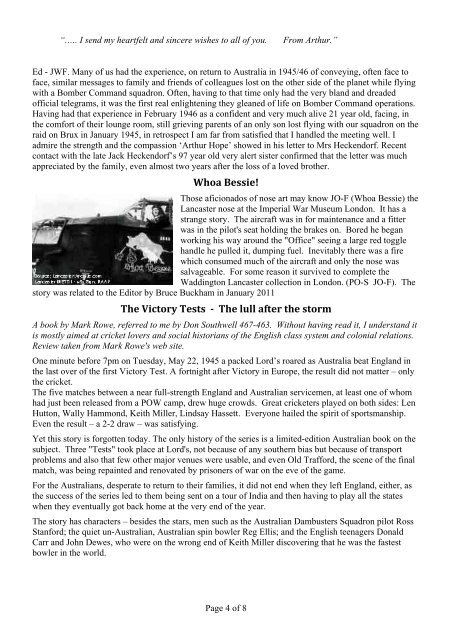BOMBER COMMAND ASSOCIATION IN AUSTRALIA Inc.
BOMBER COMMAND ASSOCIATION IN AUSTRALIA Inc.
BOMBER COMMAND ASSOCIATION IN AUSTRALIA Inc.
Create successful ePaper yourself
Turn your PDF publications into a flip-book with our unique Google optimized e-Paper software.
“….. I send my heartfelt and sincere wishes to all of you. From Arthur.”<br />
Ed - JWF. Many of us had the experience, on return to Australia in 1945/46 of conveying, often face to<br />
face, similar messages to family and friends of colleagues lost on the other side of the planet while flying<br />
with a Bomber Command squadron. Often, having to that time only had the very bland and dreaded<br />
official telegrams, it was the first real enlightening they gleaned of life on Bomber Command operations.<br />
Having had that experience in February 1946 as a confident and very much alive 21 year old, facing, in<br />
the comfort of their lounge room, still grieving parents of an only son lost flying with our squadron on the<br />
raid on Brux in January 1945, in retrospect I am far from satisfied that I handled the meeting well. I<br />
admire the strength and the compassion ‘Arthur Hope’ showed in his letter to Mrs Heckendorf. Recent<br />
contact with the late Jack Heckendorf’s 97 year old very alert sister confirmed that the letter was much<br />
appreciated by the family, even almost two years after the loss of a loved brother.<br />
Whoa Bessie!<br />
Those aficionados of nose art may know JO-F (Whoa Bessie) the<br />
Lancaster nose at the Imperial War Museum London. It has a<br />
strange story. The aircraft was in for maintenance and a fitter<br />
was in the pilot's seat holding the brakes on. Bored he began<br />
working his way around the "Office" seeing a large red toggle<br />
handle he pulled it, dumping fuel. Inevitably there was a fire<br />
which consumed much of the aircraft and only the nose was<br />
salvageable. For some reason it survived to complete the<br />
Waddington Lancaster collection in London. (PO-S JO-F). The<br />
story was related to the Editor by Bruce Buckham in January 2011<br />
The Victory Tests The lull after the storm<br />
A book by Mark Rowe, referred to me by Don Southwell 467-463. Without having read it, I understand it<br />
is mostly aimed at cricket lovers and social historians of the English class system and colonial relations.<br />
Review taken from Mark Rowe's web site.<br />
One minute before 7pm on Tuesday, May 22, 1945 a packed Lord’s roared as Australia beat England in<br />
the last over of the first Victory Test. A fortnight after Victory in Europe, the result did not matter – only<br />
the cricket.<br />
The five matches between a near full-strength England and Australian servicemen, at least one of whom<br />
had just been released from a POW camp, drew huge crowds. Great cricketers played on both sides: Len<br />
Hutton, Wally Hammond, Keith Miller, Lindsay Hassett. Everyone hailed the spirit of sportsmanship.<br />
Even the result – a 2-2 draw – was satisfying.<br />
Yet this story is forgotten today. The only history of the series is a limited-edition Australian book on the<br />
subject. Three "Tests" took place at Lord's, not because of any southern bias but because of transport<br />
problems and also that few other major venues were usable, and even Old Trafford, the scene of the final<br />
match, was being repainted and renovated by prisoners of war on the eve of the game.<br />
For the Australians, desperate to return to their families, it did not end when they left England, either, as<br />
the success of the series led to them being sent on a tour of India and then having to play all the states<br />
when they eventually got back home at the very end of the year.<br />
The story has characters – besides the stars, men such as the Australian Dambusters Squadron pilot Ross<br />
Stanford; the quiet un-Australian, Australian spin bowler Reg Ellis; and the English teenagers Donald<br />
Carr and John Dewes, who were on the wrong end of Keith Miller discovering that he was the fastest<br />
bowler in the world.<br />
Page 4 of 8


